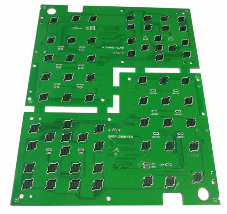Principle of HotBar
HotBar (Hot-Pressed Melt Soldering) is also known as "Pulse Hot-Pressing Soldering", but most people in the PCB industry call it "HotBar". The principle of HotBar is to print solder paste on a circuit board (PCB). On the soldering pad, after the reflow furnace, the solder paste is melted and pre-soldered on the circuit board, and then the object to be soldered (usually FPC) is placed on the circuit board that has been printed with solder paste, and then the thermal head is used The heat melts the solder and connects the two PCB components that need to be connected.
Because a long hot press head is used to solder the flat object to be soldered (usually FPC) on the circuit board, it is called HotBar. Personally, I think its name is to distinguish the HeatSeal process, which is also used to paste the ACF on the LCD or circuit board with a thermal head.
HotBar usually solders the soft board (FPC) on the PCB, so that it can achieve the purpose of lightness, thinness, shortness and smallness. In addition, the cost can be effectively reduced, because 1 to 2 FPC connectors can be used less.

The principle of the general HotBar hot press is to use the huge [Joule heat] generated when the [pulse current (pulse)] flows through molybdenum, titanium and other materials with high resistance characteristics to heat [thermodes/heater] tip), and then use the thermal head to heat and melt the existing solder paste on the PCB to achieve the purpose of mutual soldering.
Since pulse heating is used, pulse energy and time control are very important. The control method is to use the thermocouple circuit at the front of the thermal head to instantly feedback the temperature of the thermal head back to the power control center to control the pulse Signal to ensure the correctness of the temperature on the thermal head.
HotBar process control
▪ Control the gap between the thermal head and the object to be pressed (usually PCB). When the hot pressing head descends to the object to be pressed, it must be completely parallel to the object to be pressed, so that the heating of the object to be pressed will be even. The general approach is to loosen the screw that locks the hot press head on the hot press first, and then adjust to manual mode. When the hot press head is lowered and pressed against the object to be pressed, confirm the full contact before tightening the screw, and finally Raise the thermal head. Usually the object to be pressed is PCB, so the hot pressing head should be pressed on the PCB. It is better to find a board that is not tinned to adjust the machine.
▪ Control the fixed position of the object to be pressed. Generally, the objects to be pressed are PCB and soft board. It is necessary to confirm that the PCB and soft board can be fixed on the fixture carrier. At the same time, it is necessary to confirm that the position of the HotBar is fixed each time the HotBar is pressed, especially the front and back direction. When there is no fixed object to be pressed, it is easy to cause empty welding or crush the quality problems of nearby parts. In order to achieve the purpose of fixing the object to be pressed, when designing PCB and FPC, special attention should be paid to the design of adding positioning holes. The location is best to be near the molten tin hot pressing to avoid FPCB shifting when pressing down.
▪ Control the pressure of the heat press. Please refer to the recommendations provided by the heat press manufacturer.
▪ Is it necessary to add flux? The amount of flux can be added to facilitate welding smoothly. Of course, it is best to achieve the goal without adding it. After the solder paste is printed on the circuit board and flows through the reflow furnace, the flux in the solder paste has been volatilized, so when pressing the HotBar, it is usually necessary to add a flux to improve its soldering ability. The purpose of the flux is to remove oxides.